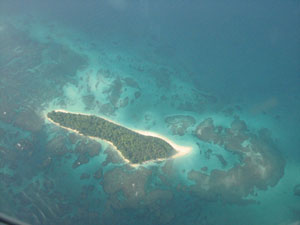 So it all started with an e-mail in February of 2007 from a woman who saw our "Rockview" floors on our Website. The concrete floors and walls she saw are in a house that overhangs the Monterey Bay on the California Coastline. She said that she had seen "veins" filled with aquarium sand, beach glass, and various seashells and she said that she "absolutely loved them." The catch was, she wanted our company to replicate this floor over 3800 miles away-- in Panama-- Bocas Del Toro to be exact which is on the Caribbean side of Panama. I was excited at the prospect thinking Tropical Island, great surf, unique and colorful floors...to a surfing concrete contractor from Santa Cruz, California this all sounded like a slice of heaven on earth to me.
So it all started with an e-mail in February of 2007 from a woman who saw our "Rockview" floors on our Website. The concrete floors and walls she saw are in a house that overhangs the Monterey Bay on the California Coastline. She said that she had seen "veins" filled with aquarium sand, beach glass, and various seashells and she said that she "absolutely loved them." The catch was, she wanted our company to replicate this floor over 3800 miles away-- in Panama-- Bocas Del Toro to be exact which is on the Caribbean side of Panama. I was excited at the prospect thinking Tropical Island, great surf, unique and colorful floors...to a surfing concrete contractor from Santa Cruz, California this all sounded like a slice of heaven on earth to me.
Next came probably the hardest part of the venture: pricing and the logistics. What would it be like to work with the native Panamanians? How long would it take to construct our floors on a small island in a Third World Country? How difficult would it be to get the "hazardous" materials to Panama? I have had enough bouts in the United States with Hazardous Materials Agencies when it came to acid staining. We always make sure that we use baking soda or ammonia and copious amounts of fresh water to rinse with Acid Stains so that all of the tests will pass and come up neutral. How would we deal with shipping Hazardous Material to Panama? How much should we charge?
The L.M. Scoffield Company was very helpful when it came time to ship their product to Panama. Sealers were also considered hazardous, even as were the water-based sealers and waxes.
After a short bit of research I found out that there were no Ready Mix Concrete Plants or Trucks on the Island of Bocas Del Toro. Obviously this spelled difficulty for our project and our main ingredient, concrete! We did know that we could make good concrete if we just had good basic ingredients. So we ordered enough of our needed materials to get started i.e. Rock, Sand and Cement. For this particular job I wanted to use White Cement as well as Grey Cement to lighten up the concrete so that the acid stained floor would have more of an opportunity to "pop."
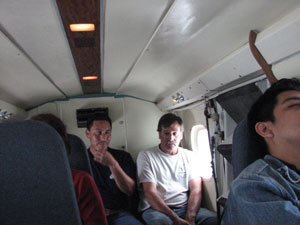 When we got to the Island it was obvious that were weren't in Kansas anymore. First of all the after we landed in Panama we had to take a small Piper Cub in order to get to the Island of Boca Del Toro. One of my foreman, Tracy Whitesell was none to fond of flying. Tracy was far less enthusiastic when he found out that the Piper Cub actually leaked and he got wet as we flew to the island. The picture of his face when he made this discovery was priceless. When we were picked up at the airport our driver took us to the site in and old truck. Ruts in the road were filled water many over 2' deep and most of them were filled with water. We saw and heard Howler monkeys that had screams that would put Chewbacca to shame as well as parrots that had wild colors and head turning squawks.
When we got to the Island it was obvious that were weren't in Kansas anymore. First of all the after we landed in Panama we had to take a small Piper Cub in order to get to the Island of Boca Del Toro. One of my foreman, Tracy Whitesell was none to fond of flying. Tracy was far less enthusiastic when he found out that the Piper Cub actually leaked and he got wet as we flew to the island. The picture of his face when he made this discovery was priceless. When we were picked up at the airport our driver took us to the site in and old truck. Ruts in the road were filled water many over 2' deep and most of them were filled with water. We saw and heard Howler monkeys that had screams that would put Chewbacca to shame as well as parrots that had wild colors and head turning squawks.
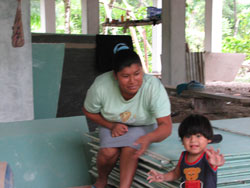 To our surprise we found that the last ingredient needed to make cement---water---was very difficult to procure. We didn't have any huge plastic containers on site to stockpile rainwater. The locals that we hired eventually gathered enough rain water from roof run-off in 55 gallon containers for our concrete mix. To make matters more interesting there was also a family that actually lived under the house that we were going to work on. A father, mother and a 2 year old were on the site 24/7 and so we decided to hire dad to help make ends meet.
To our surprise we found that the last ingredient needed to make cement---water---was very difficult to procure. We didn't have any huge plastic containers on site to stockpile rainwater. The locals that we hired eventually gathered enough rain water from roof run-off in 55 gallon containers for our concrete mix. To make matters more interesting there was also a family that actually lived under the house that we were going to work on. A father, mother and a 2 year old were on the site 24/7 and so we decided to hire dad to help make ends meet.
We were put up in a small makeshift hotel that was very close to the house that we would be working on. When I was putting my clothes away I was greeted by a large scorpion roaming about in one of my drawers. Any romantic thoughts that may have stemmed from the novelty and adventure of staying on a tropical island in the southern hemisphere were quickly lifted from my mind.
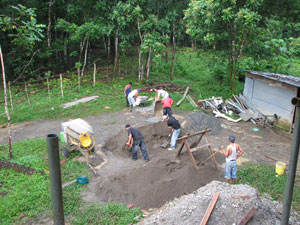 The concrete was mixed by a small 5-cubic foot gas powered concrete mixer. It took nine Panamanian men to pull the mixer up the slippery hill to the designated area where materials were staged. The available sand had too many organic impurities as well as large chunks of stone in it to use. Each batch of sand that was used for our concrete had to be flung by shovel through a tilted screen; shovel full by shovel full.
The concrete was mixed by a small 5-cubic foot gas powered concrete mixer. It took nine Panamanian men to pull the mixer up the slippery hill to the designated area where materials were staged. The available sand had too many organic impurities as well as large chunks of stone in it to use. Each batch of sand that was used for our concrete had to be flung by shovel through a tilted screen; shovel full by shovel full.
On the day before we poured I thought it would be a nice effect if we included some of the beautiful indigenous beach sand, which was about 75 yards away from the project. This sand had 1/8" sized aggregates that looked, as a result of rolling around in relentless shore crashing waves, polished. Also intermixed in the sand were many small white and off white sea shells that I could not identify but thought they would look interesting and beautiful if broadcast around on the floor. So off we went on a shell/sand procuring expedition and returned with enough broadcast to do all of the 2200 SF of floors and ramps. Later, all of these broadcast materials and embeds and broadcast material would be revealed in our wash off.
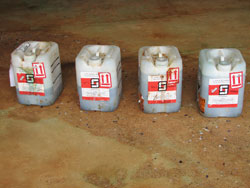 We used Scoffield Antique Amber and applied the stain with a large pump sprayer for most of the larger areas of the floor. The veined areas had highlights of Fern Green, Copper Patina and Padre Brown and these were applied with hand sprayers and small brushes. My colour man, Bill Goff who has an extensive education and background in art, added his touch to both the veins and the main body of concrete floor. The areas around the little cranny's of exposed (some indigenous and some imported) shells and aggregates were individually stained with small artists brushes. Some of those areas were darkened with stain which gave a crater like effect reminiscent of the pock marks on the shelves near the shores that are right in front of this jungle home.
We used Scoffield Antique Amber and applied the stain with a large pump sprayer for most of the larger areas of the floor. The veined areas had highlights of Fern Green, Copper Patina and Padre Brown and these were applied with hand sprayers and small brushes. My colour man, Bill Goff who has an extensive education and background in art, added his touch to both the veins and the main body of concrete floor. The areas around the little cranny's of exposed (some indigenous and some imported) shells and aggregates were individually stained with small artists brushes. Some of those areas were darkened with stain which gave a crater like effect reminiscent of the pock marks on the shelves near the shores that are right in front of this jungle home.
On the night before the pour we thought we had all of our ducks in a row but the fun started when on the following morning when we were going to make an early pour. The cement and sand did not show up at the scheduled 6:30 start time, rather we had to wait until after 11:30 a.m. for most of our materials. Now our pour was going to be jeopardized. When asked by the Panamanian project manager Titi, if I was going to need anything else I said "Absolutely! Now we are going to need lights....our late start is going to take us well into the night". The new house we were working on did not have electricity or lights and so we were going to have to used generators and whatever lights were provided. Our pour got underway and we waited and waited but the lights never arrived. We ended up finishing after midnight with candles and flashlights.
We had another big problem trying to get our sealers and waxes for our floors out of Panama City. They had been hung up in receiving for over 2-months. I finally made a personal visit after more than a half-dozen phone calls. The woman at the Port said that the epoxy sealers and acrylic waxes would likely not be arriving any time soon. She said that perhaps the officials thought that we could make drugs from our mysterious liquid. I rolled my eyes and under my breath said "Please" I started calling around the area and finally made contact with a Paint store in David which was approximately 150 miles away north of Boca del Toro and west of Panama. I left Boca on a Piper Cub and was picked up at the airport by a taxi driver. When I went to pick up the sealer what was given to me was 15 gallons of Gun Ship Grey Epoxy! I was miffed but nothing I could do. The taxi driver and I went to 4 other hardware and paint stores until we found a brand of clear epoxy for concrete. I had never used this particular brand of epoxy but it was the only one that I could find. Sixteen hours later I brought the clear epoxy to the job site. The floors and ramps that were acid stained with the Scoffield colors were washed and neutralized with ammonia. Surprisingly the clear coat is holding up well.
All of the hassles aside, the white cement that we added to our mix was just what the doctor ordered. As we were washing and neutralizing the acids, the colors that we revealed popped out of the floor perfectly. The natives and residents that came by the house loved the floors. As you looked from the floors to the jungle outside we were amazed at how the greens and browns of the jungle foliage with all of its shiny multi-colored green leaves were perfectly toned and perfectly matched with our acid stained concrete. We were all absolutely ecstatic that we were not only able to complete the floors but also complete them in a beautiful and artistic way. We were able to pour a difficult project with one small hand mixer; concrete that was finished by candlelight—not to mention that this was completed in the jungles of Panama without fresh running water.
Above and beyond how difficult it was to work in Panama, the final product is amazing and would be so in any part of the world. The pastel colors in the floor were brought out by the white cement and the blended Scoffield Acid Stains, producing a pastel colored floor. In a word they turned out stellar. The "islands of rock glass and shells" coupled with the subtle colored stains blended right into the Bocas Shoreline and the Bocas jungles. We compared the photos from the air of the Bocas archipelago and certain sections of the bathrooms and bedrooms and found an incredible similarity. Our sentiments were both validated and punctuated by the owner's booming exclamation "I now have the nicest floors in Panama."